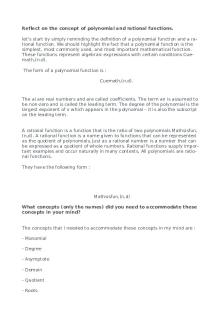Converting-unit-rates college algebra PDF

| Title | Converting-unit-rates college algebra |
|---|---|
| Course | College Algebra |
| Institution | University of the People |
| Pages | 3 |
| File Size | 132.3 KB |
| File Type | |
| Total Downloads | 23 |
| Total Views | 173 |
Summary
Converting-unit-rates - college algebra - lecture notes 1. Converting Units
2. Unit Rates
3. Converting Unit Rates...
Description
Converting Unit Rates by Sophia Tutorial
WHAT'S COVERED
1. Converting Units 2. Unit Rates 3. Converting Unit Rates
1. Converting Units When converting from one unit to another, we multiply a quantity by a conversion factor. A conversion factor is a fraction equivalent to 1, so multiplying it by a quantity doesn't change its actual measure. However, the fraction certainly doesn't look like it's equal to one (at least not until you inspect it). The expressions in the numerator and denominator are equal quantities, but measured in different units. During unit conversion, units are also canceled out when they appear in both the numerator and the denominator. To illustrate this idea, let's convert 1.5 feet into inches, using the fact that 1 foot is equivalent to 12 inches.
Create fraction multiplication
Multiply numbers, multiply units
Units of feet cancel Our Solution
2. Unit Rates A unit rate is a ratio between two quantities with different units. For examples, speed is a unit rate, because it is the ratio between distance traveled and the time taken to travel that distance. There are two different types © 2019 SOPHIA Learning, LLC. SOPHIA is a registered trademark of SOPHIA Learning, LLC.
Page 1
of units that make up this ratio, distance and time. Another characteristic of a unit rate is that a unit rate has a denominator of 1. Let's think about speed again: we wouldn't normally say that a car travels 120 miles per 2 hours. Instead, we simplify the ratio to 1 hour, and say 60 miles per hour.
3. Converting Unit Rates When converting unit rates, we need to make use of multiple conversion factors: as many conversion factors needed to convert from one quantity to another for every unit involved in our unit rate. Let's work more with miles per hour, and convert 60 miles per hour into feet per second. We'll need to convert miles to kilometers, but also hours to seconds. Let's first list our conversion factors:
HINT
When using a conversion factor to create a fraction equal to 1, think about what unit you wish to convert into. In most cases, this will be the numerator of the fraction, which places the unit you wish to cancel in the denominator of that fraction. This is because the unit you wish to cancel will likely be in the numerator of another fraction. Units are canceled when they appear in the numerator and denominator of the combined fraction.
HINT
Keep in mind that although we have listed some very helpful conversion factors, we may not need to use all of them. For example, as we will see when we are converting from miles per hour into feet per second, we will use the conversion factor that 1 mile = 5280 feet, instead of 1 foot = 0.0002 miles. This all depends on which unit you want to convert into and which unit you wish to cancel.
This conversion factor cancels miles
The second conversion factor cancels hours
Multiply all fractions, noting canceled units
Divide 316800 by 3600, for a denominator of 1 Our Solution
SUMMARY
© 2019 SOPHIA Learning, LLC. SOPHIA is a registered trademark of SOPHIA Learning, LLC.
Page 2
When converting units units, we multiply a quantity by a conversion factor. Unit rates are ratios comparing two quantities with different units. Conversion factors, which can be used to convert between different units, can also then be used when converting unit rates rates.
© 2019 SOPHIA Learning, LLC. SOPHIA is a registered trademark of SOPHIA Learning, LLC.
Page 3...
Similar Free PDFs

College Algebra
- 32 Pages

College Algebra Chapter 3.2
- 2 Pages

College Algebra Textbook Solutions
- 46 Pages

College algebra word problems
- 5 Pages

DP Unit 5 - College Algebra
- 2 Pages

journal unit 3 - college algebra
- 3 Pages

College Algebra Review QUIZ 1
- 12 Pages
Popular Institutions
- Tinajero National High School - Annex
- Politeknik Caltex Riau
- Yokohama City University
- SGT University
- University of Al-Qadisiyah
- Divine Word College of Vigan
- Techniek College Rotterdam
- Universidade de Santiago
- Universiti Teknologi MARA Cawangan Johor Kampus Pasir Gudang
- Poltekkes Kemenkes Yogyakarta
- Baguio City National High School
- Colegio san marcos
- preparatoria uno
- Centro de Bachillerato Tecnológico Industrial y de Servicios No. 107
- Dalian Maritime University
- Quang Trung Secondary School
- Colegio Tecnológico en Informática
- Corporación Regional de Educación Superior
- Grupo CEDVA
- Dar Al Uloom University
- Centro de Estudios Preuniversitarios de la Universidad Nacional de Ingeniería
- 上智大学
- Aakash International School, Nuna Majara
- San Felipe Neri Catholic School
- Kang Chiao International School - New Taipei City
- Misamis Occidental National High School
- Institución Educativa Escuela Normal Juan Ladrilleros
- Kolehiyo ng Pantukan
- Batanes State College
- Instituto Continental
- Sekolah Menengah Kejuruan Kesehatan Kaltara (Tarakan)
- Colegio de La Inmaculada Concepcion - Cebu








